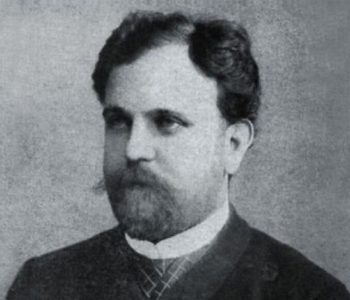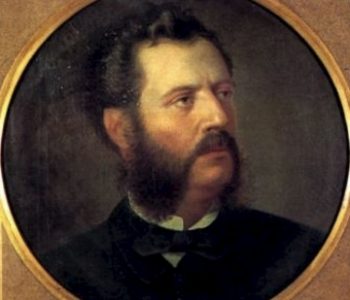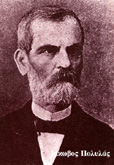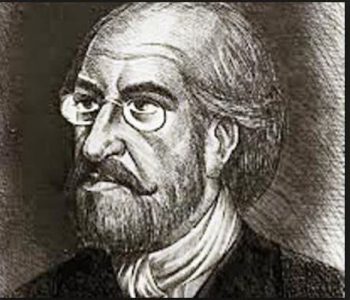
Introduction by R. Nicolì
This digital edition reproduces, within the POLYSEMI Library, the first seventeen letters included in Viaggio in Grecia by Saverio Scrofani, which consists of sixty letters. They have been copied from the text published by Edizioni dell’Ateneo (Rome, 1965) and philologically edited by Claudio Mutini.[1]
The author was born in the province of Ragusa in 1756 and belonged to a simple family that entrusted a maternal uncle, the bishop of Syracuse, with Saverio’s education, hoping he could become a priest. However, disappointing his family expectations, Scrofani lived a quite immoral and troubled life, and devoted to gambling and worldliness. Nevertheless, he has never neglected his studies focused on economy and specific agricultural topics, so as to be extremely prolific in writing the results of his research. He belonged to that generation of intellectuals who, despite being educated within the principles of the Enlightenment, had to disseminate his writings in the changed context of Reforming Absolutism.
During the years of his decision to leave for Greece, he is at the peak of his social success, he has been staying in Venice for a long time and has had so many experiences (including the French Revolution, he directly witnessed[2]) that he approached this journey as a lucid and balanced observer as well as a competent narrator who will use this ability to communicate what he has seen, known and assimilated.
This kind of trip was not so common among the Italian intellectuals (although they daydreamed a lot about it) as compared with their French, English and German contemporaries. The journey started from Venice on 24 July 1794 and finished in October 1795; it was made by ship, along the traditional route of Venetian vessels, going past Istria and Dalmatia, moving to the Ionian Islands, and later proceeding to east Greece.
The account of this experience will be published in two volumes in Rome in 1799 by Salvioni, the official printer of the Roman Republic, who mendaciously indicates London as the place of publication. On the contrary, we have very few information on a second journey to Greece, made between 1796 and the first months of 1798; it is only mentioned in the Relazione su lo stato attuale dell’agricoltura e del commercio della Morea, a lively and attractive text that reveals the reforming interest of the author, as an economist and agronomist.
Meanwhile, the text published by Salvioni, translated also into German and French, was censored and withdrawn from the market.[3] Cesarotti, in a private letter to Countess Francesca Morelli, praises the Sicilian author’s text and argues that he could not understand the reasons for that decision, since the travel account showed “nulla d’eterodosso”.[4] Only after long and careful revisions, the writer will be able to republish it in Palermo thirty-two years later, in 1831, by the publisher Abbate.
The text is a travel report, a very common and appreciated genre at that time, but written in the form of letters. His “lettere si suppongono effettivamente inviate, come si desume dalle iniziali di nomi riportate nel corpo delle missive dalle varie località raggiunte nel percorso; e così si dica di allusioni inserite qual e là nel racconto (anche con cognomi incompleti, ma facilmente ricostruibili nella loro interezza da parte dei lettori contemporanei”.[5]
The travel letter is a means of transmitting the experience to people that did not have it, hence it is expected to meet criteria of ‘truth’, more than any other travel literary text. However, even though the travel account suggests that all subjective elements are projected outwards by making ‘objective’ the traveler’s experience, such experience is inevitably distorted by memory and communications codes. The simple description of the places visited, the people met and the events is accompanied by the account of subjective experience.
In the course of its history, travel literature has inevitably fluctuated between these two traits: the objective representation of places and the subjective enhancement of that experience. On the one hand, we find the world (natural, cultural, social, etc.) and, on the other, we find the protagonist of the feat, with his ideas and impressions. Saverio Scrofani’s letters belong to those travel texts that mix the two traits, but are more inclined to present the traveler and narrator’s point of view and enhance his personal experience. Hence, we may agree with Marco Cerruti, who identifies two levels of interpreting Viaggio in Grecia: the account and the narration.[6] The description of the Enlightenment adventure among the vestiges of classical antiquity is sometimes harmoniously accompanied by a narration that has mundane entertainment connotations.
When he collects the various letters into a unique corpus, Scrofani adds a Dedication to his friends, in which he specifies that he does not aim to offer mere descriptions and material neither to those scholars who want to know Greece nor to antiquarians, who then tried to satisfy their need to retrace human events going back in time as much as possible. The author’s purpose is rather to “delight” his potential readers. The text shows, rather than Rousseauian and Enlightenment elements, echoes of the sentimental journey European literature (see Sterne,[7] Barthélemy, and Volney), in which the way of looking at ancient Greece anticipates the lyrical nature that Hellas myth will acquire in the great European Romantic authors.[8]
From the beginning of his journey, the author establishes a relationship between his inner being and the outer world; in fact, he describes to his addressees the emotions the places arouse, whether provoked by the curiosity about what he is going to meet or by nostalgia for what he left. For example, in Letter II he writes the following words with a tone of melancholy that reveals the link between his eyes and heart: “salendo una collina, mi assisi sopra una rocca che dominava il porto, ed il territorio di Città Nuova coperto di vigne. Ma non era quello il momento d’occuparmi della Campagna. I miei occhi non sapevano dirigersi che verso il mare: cercava di scoprire le terre d’Adria, indi quelle di Venezia, ma fu inutile, e non potei ritrovarla che nel mio cuore”.
In Letter V Scrofani, after sailing around the Dalmatian coasts – observed with no particular interest, just as a necessary step to a different destination – starts to describe the Greek territory; mythical and historical times overlap when he turns his gaze towards its coasts: the view of the Ceraunian Mountains, the Epirus mountains and Corfu coast reminds him such names as Alexander and Pyrrhus, as well as Alcinous, Nausicaa, and Odysseus. In Letter XI he is upset before Lefkada white cliff, on which the always restless sea breaks, recalling Sappho’s story. His dismay is so deep that he says: “Alle porte d’ogni città, si dovrebbe trovare un salto di Leucade: gli amanti disperati ritornerebbero saggi o finirebbero di penare, e i governi sarebbero più tranquilli”.
Not only myth and history, but also the whole Greek landscape is observed and introjected by the author. This landscape is also a center where new interpretations of artistic, archaeological, agricultural, anthropologic, and folkloristic aspects meet. Everything finds its natural and organized position in Scrofani’s text thanks to the author’s inclination to assimilate the most various and stimulating experiences.
Corfu description reveals the writer’s inclination for analysis that is typical of Enlightenment and the legacy of his previous knowledge of commercial issues; he wonders: “ma dove vanno a perdersi 300.000 giare d’olio che si estraggono annualmente da Corfù? a Venezia. E 100.000 zecchini che vi lascia ogni anno l’armata veneta? A Venezia. Per chi travagliano i 60.000 abitanti del paese?”. It is one of the few passages in which, in a break in narration, his critical attitude towards Corfu inhabitants emerges: we see a polemic outburst against them, accused of searching for “una scusa alla propria infingardaggine”, as poor and lazy people do, unable to change the state of affairs.
Letter XV, written in Zakynthos, with no perception of discontinuity with the content of the previous letters, is devoted to the narration of a love story related to contemporary news. The myth of love, constant in European culture and civilization that had its roots just in ancient Greece, is revived here and becomes the plot of a story recalling the Decameron fourth day unhappy love. The protagonist is Elena Mattaranga, a twenty-year-old girl, haunted by the ghost of a man that her family had separated from her. The narration of this gloomy story aims to convey to the letter addressee the author’s view on Greek women: they are considered as epigones of ancestral civilization and valuable signs of the past, rich in beliefs and traditions. In the same letter, the power and beauty of Zakynthos women leads the writer to a sort of idealization; in fact he writes: “la bellezza del sesso femminile in un paese è il primo segno d’ospitalità […]. Per conoscere la dolcezza d’un popolo i viaggiatori non dovrebber far altro che osservar prima le donne; se queste son belle devono essere umane e avranno in conseguenza ammansita la naturale ferocia degli uomini”.
The view of Greece inevitably leads to a comparison between its ancient grandeur and current decline, dramatically enhanced by the cruelty of Turkish rulers, an ignorant people: “Questa è dunque la Grecia?” – he questions in Letter XVII, the last included in this digital edition. Here the writer also illustrates the reasons for travelling, related not only to a desire for knowledge, but also to the urge to ‘feel’: “Non poteva io, leggendo gli antichi e i moderni viaggiatori, sapere senza molto stento ciò ch’esiste oggi in Grecia, ciò che vi esisteva una volta? Sì, tutto è vero; ma io non avrei fatto allora altro viaggio che per istruirmi, e voleva farne uno per sentire, aveva bisogno di spossare tutta la sensibilità del mio cuore per vivere con gli uomini d’oggidì; aveva bisogno, per così dire, d’indurirmi contro me stesso a forza di sentire”.
The Viaggio in Grecia, belonging to philhellenic literature spread throughout Europe between the Enlightenment and Romanticism, allowed modern critics to consider its author the real forerunner of the Sicilian philhellenic movement[9]. Scrofani’s account is a hybrid text, between literature and scientific analysis, between sentimental recalling of mythological past and interest in describing the social and political context of that time. It is the result of his experience as a direct witness of the ongoing changes in that territory that had always attracted European intellectuals strongly, at first for its classical vestiges to be rediscovered and later for the geographic, political, and military events it went through.
-
We are going to mention further editions that have been consulted but not used to create this digital edition: Saverio Scrofani, Viaggio in Grecia, a cura di R. Ricorda, con una prefazione di C. Magris, Marsilio, Venezia 1988. It reproduces letters XII, XV, XVII, XX, XXII, XXVII copied by Ricorda following the 1831 edition. As Ricorda, also Carlo Cordié refers to the 1831 edition; he reproduces a high number of letters in the text he edited: Saverio Scrofani, Viaggio in Grecia, Martello, Milano 1945. Scrofani’s work is also included within the free online texts published by the Manuzio project, which chose to propose the first edition, published in 1799, entirely, including also typos. The editor justifies this decision, arguing that it reflects “in maniera più genuina e immediata lo spirito di Scrofani viaggiatore”. The text is available at: https://www.liberliber.it/mediateca/libri/s/scrofani/viaggio_in_grecia/pdf/scrofani_viaggio_in_grecia.pdf
(last accessed on 3th March 2019). ↑
-
In 1793 Saverio Scrofani, who was an attentive observer of the French Revolution development, in the delicate transition from the dissolution of the National Constituent Assembly to the opening of the Legislative Assembly, published a fortunate pamphlet named Tutti han torto, which caused a stir in the last decade of the eighteenth century, so as to be reprinted fifteen times in about two years. In 1794 he published Tutti han ragione, in which, in line with the previous pamphlet, he analyzed the Revolution economic causes, illuminating not minor aspects of the ongoing crisis in France. See: C. Capra, V. Castronuovo e G. Ricuperati, La stampa italiana dal ‘500 all’800, Laterza, Bari, 1986, pp. 387 e ss. ↑
-
See: Claudio Mutini, Viaggio in Grecia di Saverio Scrofani: ricerche sulle vicende editoriali, in «Annali della Scuola Speciale per Archivisti e Bibliotecari dell’Università di Roma», a. II, n.2, luglio-dicembre 1962, pp. 231-267. ↑
-
Saverio Scrofani, Viaggio in Grecia, a cura di Claudio Mutini, Edizioni dell’Ateneo, Roma, 1965, p. XXV. ↑
-
Carlo Cordié, L’abate Saverio Scrofani e i corrispondenti del Viaggio in Grecia. Con alcune note di Madame De Staë e il “Paragone delle donne francesi con le italiane”, in «La rassegna della letteratura italiana», serie VII, n. 1-2, gennaio-agosto 1981, p. 31. ↑
-
M. Cerruti, Il «Viaggio in Grecia» di Saverio Scrofani: un episodio di spicco della metamorfosi dei lumi, in AA. VV., L’occhio e la memoria. Miscellanea di studi in onore di Natale Tedesco, Editori del Sole, Palermo 2004, pp. 250 e ss. ↑
-
In 1792 Scrofani had just finished translating A Sentimental Journey by Sterne. ↑
-
See: Carmelo Spalanca, Verso l’Europa: il Viaggio in Grecia di Saverio Scrofani, in AA. VV. Studi in onore di Nicolò Mineo, Facoltà di Lettere e Filosofia dell’Università di Catania, 2005-2008, tomo IV, pp.1797-1810. ↑
-
See on this topic Arnaldo Di Benedetto: Le rovine d’Atene: Letteratura filellenica in Italia tra Sette e Ottocento, in «Italica», vol. 76, N°. 3, 1999, pp. 335-354. ↑
Ergographia
Selected literature






